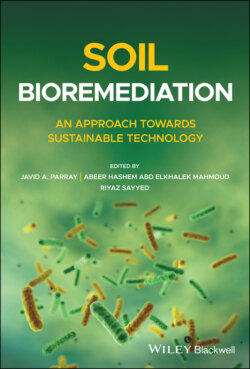Читать книгу Soil Bioremediation - Группа авторов - Страница 47
3.1 What Is Laccase?
ОглавлениеLaccase is an important oxidase enzyme, which is widely used industry. The multiple potential applications of laccase in these industries define this particular enzyme as a promising alternative to existing costly and polluting processes [1–4].
Laccase is one of a small group of enzymes called the large blue copper proteins or blue copper oxidases that have been the subject of study since the end of the last century. The blue oxidases have been intensively studied because they have the ability to reduce molecular oxygen to water [5, 6]. Laccase (benzenediol: oxygen oxidoreductase, EC 1.10.3.2) contain 15–30% carbohydrates and have a molecular mass of 60–90 kDa. These are glycosylated polyphenol oxidases that contain four copper ions per molecule that carry out one electron oxidation of phenolic and its related compound and reduce oxygen to water [4]. Laccases oxidize a surprisingly wide variety of organic and inorganic compounds, including diphenols, polyphenols, substituted phenols, diamines, and aromatic amines, with concomitant reduction of molecular oxygen to water [7]. Laccases exhibit a broad substrate range, which varies from one laccase to another. Although it is known that diphenol oxidase, monophenols like 2, 6‐dimethoxy phenol or guaiacol may also serve as substrates. Laccases catalyze monoelectronic oxidation of molecules to corresponding reactive radicals with the help of four copper atoms, which form the main catalytic core of the laccase, accompanied with the diminution of oxygen to water molecules and simultaneous oxidation of substrate to produce radicals (Figure 3.1). All substrates cannot be directly oxidized by laccases, either because of their large size, which restricts their penetration into the enzyme active site, or because of their particular high redox potential. To overcome this hindrance, suitable chemical mediators are used, which are oxidized by the laccase and their oxidized forms are then able to interact with high redox potential substrate targets [8]
Figure 3.1 Oxidation of substrate with laccase enzyme.
